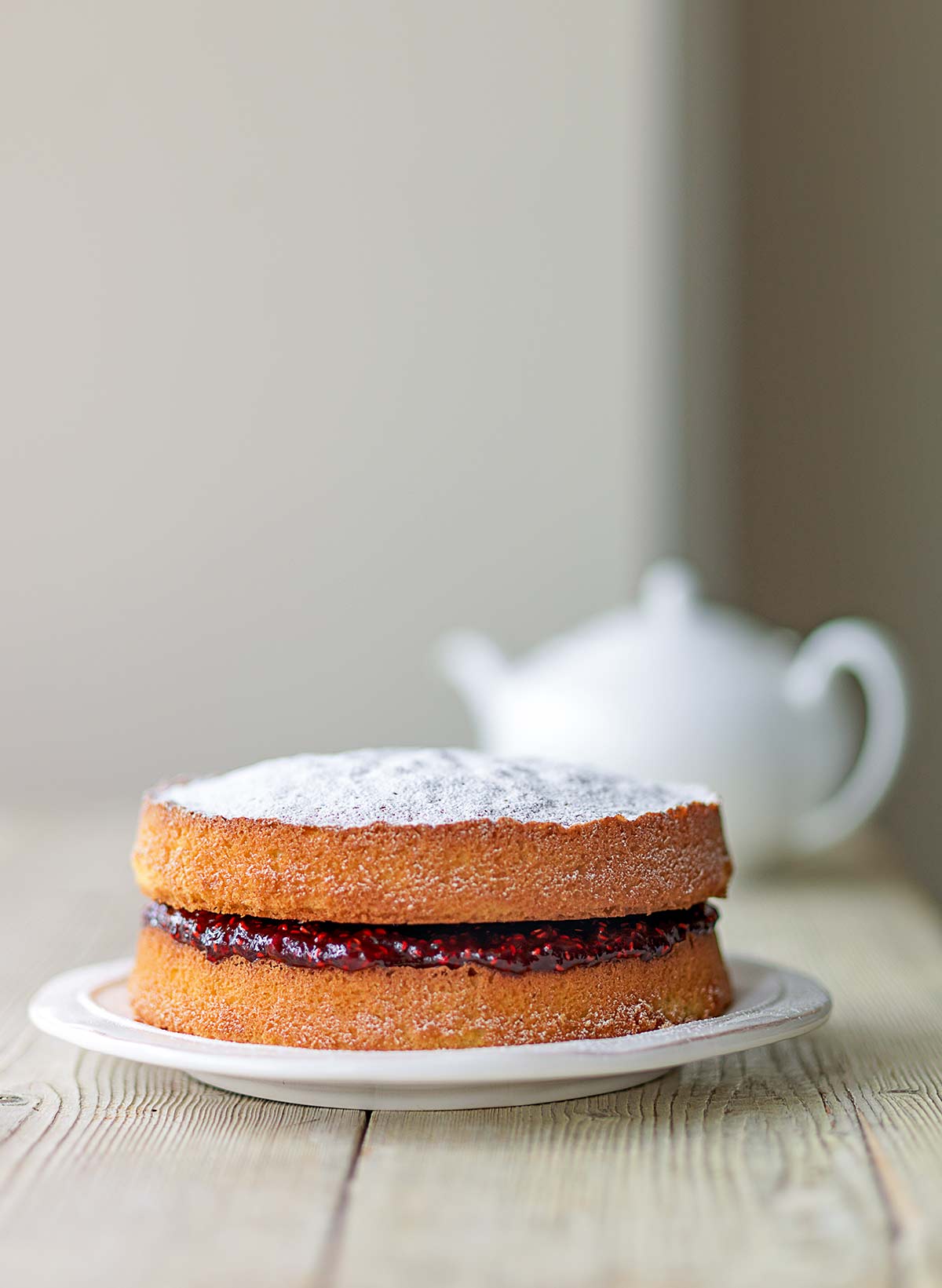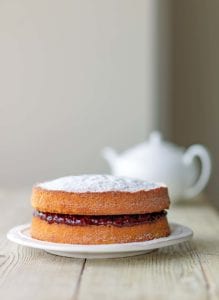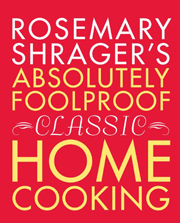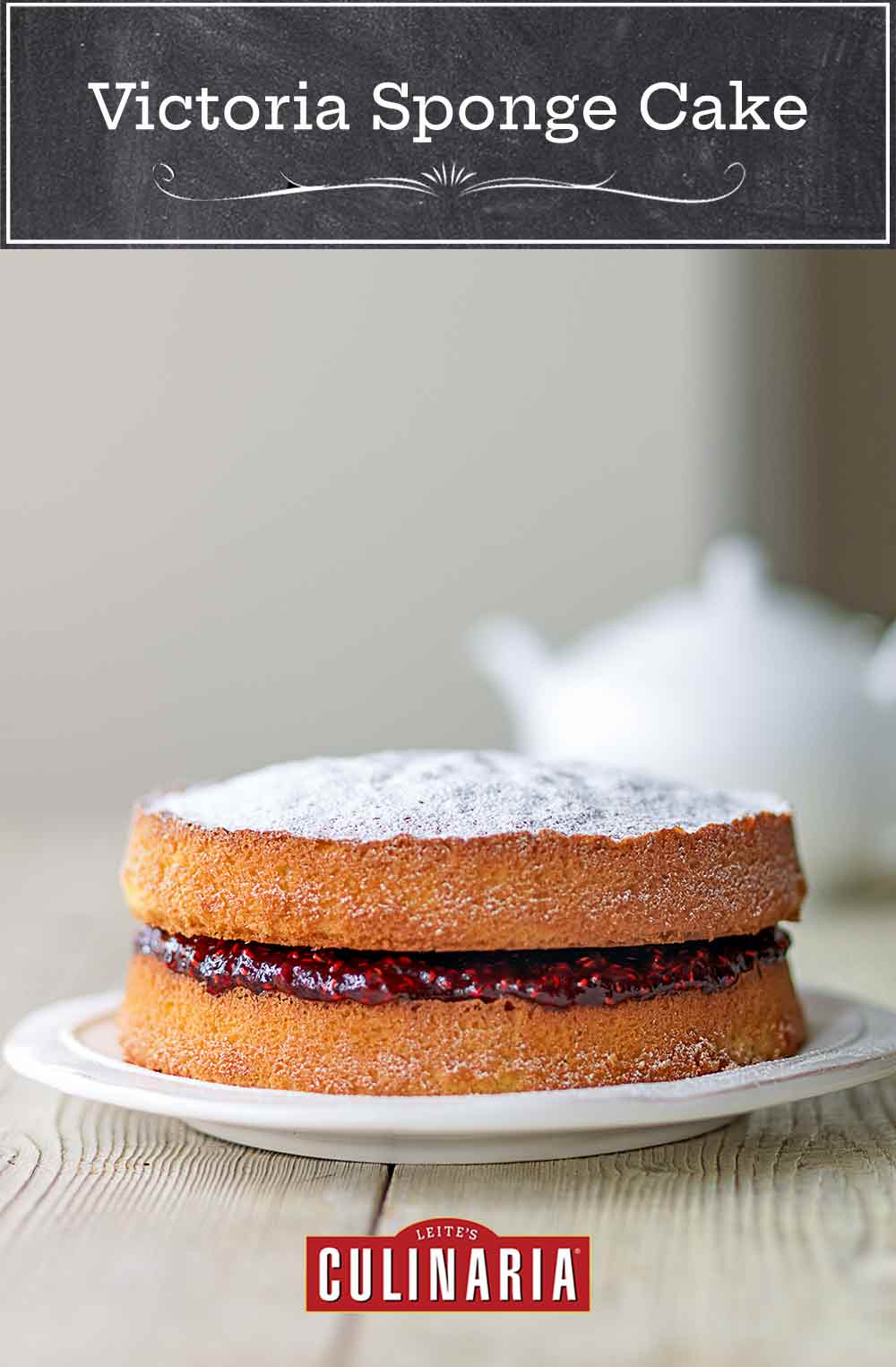
This is a very simple sponge cake, and in my opinion, one of the greatest. Once you have mastered this cake, you have the base for all sorts of variations.–Rosemary Shrager
LC A Great Mind Note
We’re swooning to this Victoria Sponge Cake, yes. This cake, a nod not just to Queen Victoria but British sensibility, defines the very notion of simple yet sophisticated. Yet we’re also sorta swooning to Rosemary Shrager and her seeming inability to not share insights when she thinks of them, seeing as her cookbook is crammed with savvy tricks and techniques. Here, a few tips she mentions in reference to her recipe that we’d rather not withhold from you:
Buttering and lining the cake pans before baking not only prevents the Victoria Sponge Cakes from sticking but also gives the cake a softer exterior.
You don’t have to stick to a round cake pan: you can use a square or oblong tin or even bake the Victoria Sponge Cake in a Pyrex dish. Do be sure to use the right size, however. A 7-inch square cake pan roughly equals an 8-inch round one. If you want to use a bigger pan, use 1 1/2 times the quantity of the mixture, or even double it, remembering that it will take a little longer to bake.
During baking, things can happen to cakes, but don’t worry–it’s usually something that’s simple to correct next time. Sometimes cakes crack or have a peak in the middle, which means the oven was too hot. If the cakes sink, the oven was too cool or you didn’t beat the mixture enough.
If you want to frost the Victoria Sponge Cake but the top of the cake has peaked slightly, you can always trim it and then turn it upside down.
When storing this Victoria Sponge Cake, I always line the containers with wax paper. Most cakes keep well in an airtight container. The higher the fat content, the better they will keep. This Victoria Sponge Cake freezes well without its filling—that is to say, when it’s still just a couple of sponge cakes and not yet a proper Victoria Sponge Cake.
Stale leftover sponge cake can be used to make trifles.

Victoria Sponge Cake
Ingredients
- 2 sticks (8 oz) unsalted butter, at room temperature, plus more for the pans
- 1 cup superfine sugar, (or just blitz granulated sugar in a blender until finely ground but not powdery)
- 4 large eggs
- 2 cups self-rising flour
- 7 tablespoons raspberry jam
- 2 tablespoons confectioners’ sugar
Instructions
- Generously butter a couple 8-inch round cake pans. Line the base of each pan with a circle of baking parchment cut to fit. Preheat the oven to 350°F (176°C).
- Beat the butter and sugar together until fluffy and almost white in color. This is easiest with an electric beater but you can instead use a wooden spoon.
- Lightly whisk the eggs together in a small bowl. Add to the butter mixture a little at a time, beating constantly. (Beating in the eggs a little at a time will mostly prevent the mixture from appearing curdled, although don’t worry if the mixture does appear so, because as soon as the flour is added it will bring it back together. The texture may be slightly denser, but the cake will be fine.)
- Now sift in the flour directly onto the mixture in 3 or 4 additions, folding each in carefully so you don’t knock out all the air you have beaten in. (You want to get under the butter mixture, turning it over rather than stirring it, and going around the sides and through the middle as gently as possible until all the flour is mixed in.)
- Divvy the batter between the 2 cake pans and level the surface. Place on the middle rack of the oven and bake for 25 to 30 minutes, until well risen and golden brown. To check if the cakes are done, press one gently in the middle with your finger—it should spring back up. If you’re still not sure, insert a skewer in the center—if it comes out clean, the cake is cooked through.
- Remove the cakes from the oven and leave in the pans for 10 minutes. Then run a knife around the edge of each one to loosen it if necessary. Turn out the cakes onto a wire rack. Let cool completely. (You can store the sponge cake in a resealable container for up to 1 week.)
- Peel off the baking parchment and place one of the cakes on a serving plate. Spread the raspberry jam over the top of that cake. Plonk the other cake on top of the jam, then sift the confectioners' sugar over the top through a fine sieve.

Nutrition
Nutrition information is automatically calculated, so should only be used as an approximation.
Recipe Testers’ Reviews
This Victoria sponge cake recipe has such perfectly balanced sweetness, and is so neutral, that you can use it as a foundation for a broad scope of sponge-based desserts. As written, the finished cake with the jam is great, but apart from this traditional Victoria sponge cake layered with preserves and served with tea, I can see this cake having a host of variations, particularly ones that moisten the cake. Think rum or strong coffee or even sweetened hot milk. I once used a cake like this for a riff on a very rustic tiramisu.
This is a nice little recipe. Even with the 4 eggs and 2 sticks butter, it’s really a very light-tasting cake with a very nice crumb.
I couldn’t get past the thought of no vanilla, almond, or even lemon extract, so I added some vanilla, which I felt was needed. I used raspberry preserves in between the 8-inch layers and dusted the cake with confectioners’ sugar and it satisfied me enough that I haven’t mixed up a creamy frosting or a pastry cream. (Yet.) I already enjoyed 2 slices of this cake. Since I have the rest of it left over, if I really want to make it rich, I may add some custard and fruit and turn it into a trifle.












I made this recipe exactly as written and was happy with the results (it compared favorably to a Victoria sponge I had in London a few weeks ago). I always weigh my ingredients when possible but questioned the weight measurements in this recipe. The standard weight of a cup of granulated sugar is 7 ounces but the ingredients list puts it at 8 ounces. Similarly, one cup of self-rising flour weighs 4.25 ounces but the ingredients list puts it at 4 ounces. I will definitely make this recipe again but am wondering if I should defer to volume rather than weight measures. Finally, I did have a bit of trouble with the mixture appearing curdled. Would you recommend using the whisk attachment rather than the paddle attachment to better incorporate the eggs before adding the flour?
Hi Lauren, I always find weight measurements more accurate in a baking recipe. As far as your issue with curdling, were all your ingredients at the same temperature? Sometimes adding a cold egg to room temperature butter can cause curdling.
Lauren, a cup of superfine sugar weighs a little more than a cup of granulated sugar. But I prefer everything less sweet anyway so always make a Victoria Sponge (a standard British recipe) with a cup of granulated sugar which, as you mentioned, weighs 7 ounces; works fine. And I use organic unbleached all-purpose flour, baking powder and salt rather than self-rising flour.
Would this be good served layered with this?
Hina, because the fool is so soft, it would just squish out of the sides. I’d make as is and top the sponge with the fool or serve it on the side.